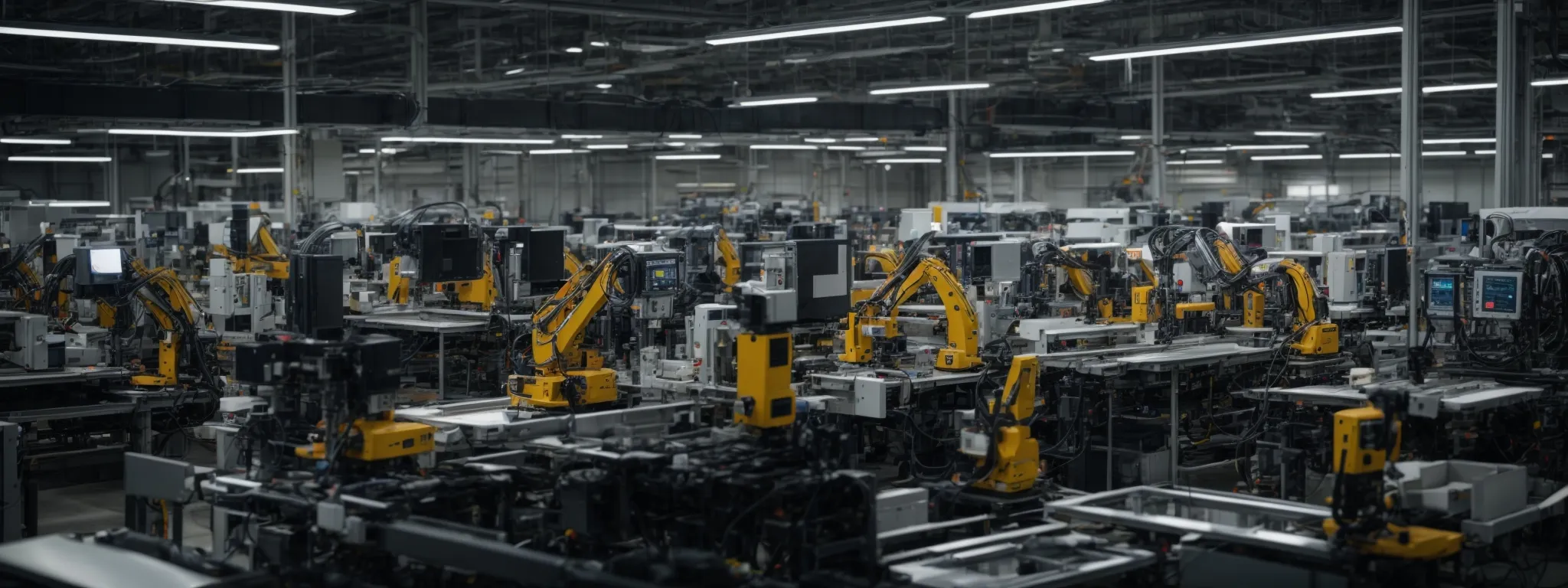AI Advancements: Exploring New Tools
AI Advancements: Exploring New Tools The acceleration of innovation in the realm of artificial intelligence is fundamentally reshaping our perception of technology’s capabilities. Groundbreaking AI tools are […]
AI Advancements: Exploring New Tools
The acceleration of innovation in the realm of artificial intelligence is fundamentally reshaping our perception of technology’s capabilities.
Groundbreaking AI tools are emerging, not merely enhancing current systems but creating entirely new paradigms for how businesses and individuals interact with digital ecosystems.
The promise of these tools extends across sectors, offering transformative solutions that streamline operations, foster creativity, and demystify complex AI processes for everyday users.
As the boundaries of science fiction and reality continue to blur, the latest AI technologies stand ready to bridge the knowledge gap, bringing powerful, user-centered applications to the forefront of the digital experience.
Keep reading to uncover the AI advancements that are setting the stage for an era of unprecedented efficiency and intuitive tech engagement.
Key Takeaways
- AI Tools Are Redefining Efficiency and Enhancing Decision-Making Processes Across Various Industries
- User-Friendly AI Platforms Are Democratizing AI Technology, Making It Accessible to a Wider Audience
- The Integration of AI With Existing Systems Is Crucial for Maintaining Operational Continuity and Data Integrity
- Investment in the Right AI Tools Can Lead to Substantial Improvements in ROI for Businesses
- Advanced AI Tools Like SearchAtlas by LinkGraph Are Setting New Standards in SEO and Digital Marketing Strategies
Unveiling the Latest AI Breakthrough Tools

The digital landscape thrives on innovation, and this year has been particularly revelatory with the announcement of groundbreaking AI software.
Stakeholders in technology and business alike are captivated by the emergent features of these new AI tools that promise to significantly enhance the capabilities and performance of machine learning applications.
Standing at the forefront of this avant-garde progression are tools that not only learn and adapt rapidly but also drive efficiency across various industries, showcasing the transformative power of artificial intelligence.
Groundbreaking AI Software Announced This Year
The arena of Search Engine Optimization (SEO) is witness to a remarkable evolution with SearchAtlas by LinkGraph emerging as a pivotal game-changer in the industry. It dares to redefine SEO reputation management, link building services, and PPC campaign management, through its innovative array of tools and services.
SearchAtlas SEO software, with its advanced algorithm and data analysis capabilities, has positioned itself as the quintessential companion for businesses looking to elevate their presence on search engines like Google and Microsoft Bing. Interactive user interface, cloud computing infrastructure, and white-label link building encapsulate the essence of LinkGraph’s Offerings:
- Effortless content optimization with the Discover SEO Content Assistant
- Comprehensive digital PR services to streamline and amplify messaging
- Insightful analytics to master the curve of Amazon PPC advertising
The Features That Set New AI Tools Apart
The distinctiveness of the latest AI tools is magnified by their unparalleled ability to decipher complex patterns in data, enhancing predictive analytics, and offering precise behavioral insights. These advancements propel businesses into a new echelon of decision-making, driven by intelligence that predicts market trends and customer preferences with noteworthy accuracy.
Revolutionary user experiences are birthed from the intersection of AI and creativity, where these tools exhibit an enriched understanding of accessibility and personalization. Through this nuanced approach, they craft user interfaces that are not only functional but also engaging, accommodating the diverse needs and preferences of users with remarkable finesse:
- Evolved machine learning models that autonomously refine their algorithm.
- Intuitive design principles integrated into AI to enhance user engagement.
- AI-driven personalization that adapts to user behavior for optimized experiences.
How the Latest Tools Are Enhancing Machine Learning
Machine learning’s newest advancements are evident in the precision and swiftness with which AI tools now process vast volumes of data: they identify intricate patterns, sharpen predictive models, and personalize experiences with unprecedented agility. These recent tools have automated complex analysis, once a time-intensive task, freeing up resources for strategic thinking and innovation.
- Innovative programming languages and development frameworks are accelerating software development, enhancing the capabilities of neural networks to mimic human thought processes.
- Enhanced user experience through intuitive interfaces ensures that technology remains accessible to professionals and enthusiasts alike, fostering an inclusive digital environment.
- Advanced personal data security measures protect the integrity of information retrieval, instilling confidence in the system’s users and maintaining critical trust.
AI tools are revolutionizing content creation, propelling businesses to new heights by transforming vast databases of knowledge into actionable insights. They employ advanced algorithms for pattern recognition, which in turn, catalyze the discovery of new opportunities and optimization strategies.
Deep Dive Into Next-Gen AI Technologies

As the digital era relentlessly forges ahead, the domain of artificial intelligence (AI) undergoes a vigorous metamorphosis, spurred by novel breakthroughs and state-of-the-art tools.
The impact of AI’s latest innovations extends beyond mere technical enhancements; it catalyzes a strategic transformation in problem-solving and decision-making processes across industries.
With new, intricate algorithms at play, AI’s advancement presents an expanded scope of possibilities, analyzing vast swathes of data with elevated intelligence and efficiency.
Concurrently, the advent of pioneering AI hardware lays the groundwork for catapulting computational power to new zeniths, thereby enabling swifter, more robust applications within the technological landscape.
Analyzing the Impact of Recent AI Innovations
Recent AI innovations have precipitated a paradigm shift in the way companies approach problem-solving and strategic planning. These new tools are empowering organizations to predict customer behavior with enhanced accuracy, thereby facilitating more effective marketing strategies and product developments.
As technology progresses, AI’s ability to assimilate and analyze vast amounts of data is setting a new standard in the field of business intelligence. This transformative wave in AI offers an unprecedented level of insight, enabling businesses to streamline operations and make timely, data-driven decisions.
The Role of New Algorithms in Advancing AI
New algorithms are the bedrock of the latest AI tools, enabling more sophisticated and nuanced applications of artificial intelligence. Their ability to learn, adapt, and predict outcomes has significantly enhanced AI systems’ performance, making inroads into new sectors and optimizing existing operations.
This evolution of algorithms heralds a new era in technology, precisely targeting and improving specific aspects of system operations, such as efficiency and accuracy:
- Increased efficiency in automated workflows by streamlining processes and reducing noise.
- Improved accuracy in information retrieval, bolstering the reliability of search engines and databases.
- Enhanced security measures, safeguarding personal data and fortifying systems against vulnerabilities.
Moreover, these advanced algorithms infuse AI with the capability to parse and understand the context within vast datasets, a stepping-stone towards genuine artificial intelligence. Embodying the bridge between raw data and actionable knowledge, they are reshaping the landscape of technology and its application across diverse industries.
Exploring the Capabilities of Cutting-Edge AI Hardware
At the cutting edge of AI technology lies an array of hardware capable of astonishing computational feats. These new architectural frameworks dramatically enhance the speed at which machine learning models can operate, streamlining complex tasks from data science to real-time language translation.
These hardware innovations not only bolster the overall performance of AI applications but also propel advancements in energy efficiency. By doing so, they enable more widespread adoption of AI technology across industries, from healthcare diagnostics to autonomous vehicle systems.
| AI Application | Impact of Hardware Advancement |
|---|---|
| Data Analysis | Accelerated computational throughput |
| Language Processing | Real-time translation and increased accuracy |
| Energy Efficiency | Reduced power consumption for sustainable use |
| Healthcare Diagnostics | Quicker, more reliable patient data processing |
| Autonomous Systems | Enhanced real-time decision-making capabilities |
AI Tools Transforming Industry Operations

The transformative impact of artificial intelligence is unfolding across the corporate spectrum, as industries are progressively adopting new AI tools to redefine their operations.
From healthcare and finance to retail and manufacturing, these technological advancements are not merely enhancing current practices but are creating entirely new paradigms for conducting business.
Success stories abound where case studies illustrate the utility of AI in delivering precise, evidence-backed outcomes, while metrics of efficiency are being dramatically rethought in the wake of AI’s ability to optimize and streamline processes.
Furthermore, emerging AI solutions are leveling the playing field, offering small and medium-sized enterprises the tools they need to compete with larger corporations.
As AI tools continue to evolve, they promise to catalyze a wave of innovation, accessibility, and growth across diverse sectors.
Case Studies of AI Application in Various Industries
In the bustling sector of retail, AI tools are revolutionizing inventory management and customer service experiences. By leveraging predictive analytics, retailers are preempting consumer demands with startling accuracy, ensuring optimal stock levels while minimizing wastage, a testament to the operational ingenuity offered by AI.
Healthcare is another domain where AI is making significant strides, with case studies showing how machine learning algorithms are improving diagnostic accuracy and treatment personalization. These advancements are invaluable in the quest for enhancing patient outcomes and streamlining care delivery, thereby reinforcing AI’s pivotal role in modernizing medical practices.
Measuring the Efficiency Gain From Advanced AI Tools
Advanced AI tools have significantly streamlined business operations, leading to marked improvements in efficiency. The quantification of this efficiency gain is most notable in their ability to rapidly process and analyze large datasets, enhancing decision-making and reducing the time cycle from research to implementation.
Companies now deploy these AI advancements to quantify their return on investment through performance metrics that reflect reduced operational costs and increased productivity. The calibration of AI efficiency is evidenced by customized dashboards and reports that illustrate progress and pinpoints areas for further optimization:
| Industry | AI Tool Application | Efficiency Gain Metric |
|---|---|---|
| Manufacturing | Automated Quality Control | Decrease in defective products |
| E-commerce | Customer Behavior Analysis | Improved conversion rates |
| Logistics | Route Optimization | Reduction in delivery times |
| Human Resources | Resume Parsing | Shorter time-to-hire cycles |
The undeniable performance enhancements brought forth by these AI tools have proven essential for businesses looking to maintain a competitive edge. With the agility to adapt to changing market conditions, AI-assisted companies can expect to achieve sustained business growth and operational excellence.
Emerging AI Solutions for Small and Medium Businesses
Small and medium-sized businesses are increasingly leveraging AI solutions to streamline their operational workflows and make data-driven strategic decisions. These enterprises use AI tools to enhance customer engagement, optimize marketing efforts, and increase overall productivity.
In a landscape dominated by larger entities, AI tools provide smaller ventures with the arsenal needed to compete on equal footing: from simplifying customer relationship management to predicting market trends with impressive precision.
| Area of Improvement | AI Tool | Impact for SMBs |
|---|---|---|
| Market Analysis | Predictive Analytics | Deeper customer insights leading to tailored strategies |
| Operational Efficiency | Automation Software | Reduced operational costs and time savings |
| Customer Support | Chatbots | Improved response times and customer satisfaction |
| Productivity | Task Management Tools | Enhanced team collaboration and workflow management |
User-Friendly AI Platforms for Non-Experts

The relentless march of artificial intelligence is not reserved for the technologically elite; recent advancements have ushered in a new era of user-friendly AI platforms.
These innovations are tailored to empower individuals with minimal programming knowledge, offering access to powerful AI capabilities through simplified interfaces.
As barriers to entry lower, a diverse spectrum of users—from entrepreneurs to educators—begins to explore the potential of AI applications.
Comprehensive tutorials and extensive resources are now readily available, providing the essential groundwork for beginners to embark on their AI journey.
This democratization of technology signals a pivotal shift, enabling a wider audience to harness AI’s transformative promise.
Examining the Accessibility of Current AI Platforms
The trajectory of artificial intelligence is arching towards inclusivity, with current AI platforms being re-engineered for accessibility. Users with rudimentary technical skills can now navigate the once complex landscape of AI, thanks to platforms boasting intuitive dashboards and simplistic controls: these advancements collapse traditional barriers and empower broader user engagement.
Recognizing the potential for pervasive AI application, developers have cultivated environments where non-experts are not only welcomed but expected. Comprehensive support systems, including robust knowledge bases and responsive customer support, cocoon the entry-level user, ensuring a positive initiation into AI utilization:
| Feature | AI Platform | Benefit for Non-Expert Users |
|---|---|---|
| Intuitive User Interface | Beginner-Friendly Design Tools | Streamlined navigation and simplified design processes |
| Support Resources | Learning-Oriented Platforms | Immediate assistance and educational content for skill development |
| Responsive Customer Service | Accessibility-Focused Platforms | Prompt problem-solving and guidance to enhance user confidence |
| Drag and Drop Features | Template-Based Web Builders | Facilitates content creation without the need for coding knowledge |
As AI continues to interweave with daily operations, its platforms are increasingly mirroring the diversity of its users. The expansion of user-friendly AI tools democratizes technology, fostering a fertile ground for creativity and growth among an ever-expanding user base.
AI Tools That Require Minimal Programming Knowledge
The landscape of AI tools has evolved to accommodate a growing audience that lacks the intricate programming knowledge once deemed necessary. Services like SearchAtlas SEO software are paving the way, offering platforms where pattern recognition, data analysis, and content optimization are accessible through a clear, user-friendly interface.
LinkGraph’s suite of AI-powered tools, such as their Keyword Researcher tool, embrace drag and drop functionalities and feature-rich dashboard designs. This allows users to implement sophisticated SEO strategies without having to delve into complex source code:
| AI Tool Feature | Benefit for Users |
|---|---|
| Drag and Drop Functionality | Simplifies complex SEO tasks |
| User-Friendly Dashboards | Enables thorough data visualization without technical expertise |
| Pre-Built SEO Templates | Facilitates quick and effective campaign setup |
Tutorials and Resources for Beginners in AI
The advent of AI has necessitated a parallel development of educational resources crafted to facilitate new users’ mastery of these tools. Recognizing the complexity that AI can present, pioneers in this field have curated an array of tutorials, online courses, and workshops, explicitly designed to break down advanced concepts into digestible lessons for neophytes.
These learning resources are integral to fostering a self-sufficient user base equipped with the knowledge and skills required to effectively deploy AI tools. Beyond simplifying entry into AI utilization, they imbue beginners with confidence, ensuring that even without a background in data science or computer programming, they can unlock the potential of AI for personal and professional enrichment.
Bridging the Gap With AI Interoperability Tools

The relentless march of technological progress presents a landscape rich with opportunities for operational enhancement via artificial intelligence.
Amidst this digital proliferation, a critical frontier has emerged: the need to seamlessly integrate AI with pre-existing systems.
This integration extends the transformative impact of AI across an organization’s infrastructure, maintaining the continuity of operations while capitalizing on AI’s advancements.
The discussion now pivots to tools that facilitate AI integration, addressing compatibility issues head-on, and ensuring the integrity of data transfer within the realm of AI interoperability.
These tools not only bridge gaps but also fortify the foundations of businesses keen on forging ahead with AI at the helm of innovation.
Tools That Facilitate AI Integration With Existing Systems
In the dynamic sphere of artificial intelligence, interoperability tools stand as key enablers that connect the newest technological strides with established systems. They serve as conduits, ensuring that cutting-edge AI solutions smoothly integrate with legacy databases and applications, thus preserving the vital harmony between innovation and functionality.
These tools operate on the front lines of compatibility, adept at translating diverse data formats and protocols into a unified language understood by disparate systems. Meticulously designed, they mitigate the risks of data discontinuity and equip organizations with the agility needed to deploy AI integrations without disrupting their operational flow:
| Integration Challenge | AI Interoperability Tool Solution | Outcome for Systems |
|---|---|---|
| Data Format Disparities | Format Translation Mechanisms | Seamless data mapping and exchange |
| Protocol Incompatibilities | Protocol Bridge Software | Unified communication across platforms |
| Legacy System Limitations | AI-Enhanced Integration Layers | Extended functionality with AI capabilities |
Overcoming Compatibility Issues With New AI Solutions
Emerging AI solutions bring a promise of seamless compatibility, nullifying the once prevalent challenges that hindered the integration of advanced AI tools with legacy systems. Elegantly designed APIs and middleware solutions now act as proficient intermediaries, ensuring fluid communication between new and existing infrastructures.
Businesses equipped with these innovative AI technologies witness a marked transformation, one where system interoperability is no longer an obstruction but a gateway to robust, streamlined operations. The newly crafted AI solutions elegantly resolve compatibility issues, weaving disparate system architectures into a cohesive, future-ready tapestry of technology.
Ensuring Data Transfer Integrity With AI Interoperability
AI interoperability tools are critical in maintaining the integrity of data transfer across various platforms and systems within an organization. These tools ensure that as data migrates from one system to another, its accuracy, completeness, and consistency remain intact, facilitating reliable and actionable insights for decision-makers.
The challenge of integrating disparate systems is elegantly addressed by sophisticated AI interoperability frameworks capable of preserving the fidelity of the transferred data. Such tools are essential for businesses to leverage the full potential of their accumulated data assets without risking the introduction of errors or data corruption during the integration process.
Investing in AI: Tools That Promise High ROI

In an era where artificial intelligence (AI) is reshaping the contours of industries, discerning investors and business leaders are focusing their gaze on AI tools that not just innovate but also deliver a strong return on investment (ROI).
Identifying AI tools with compelling potential for high returns, conducting rigorous cost-benefit analyses, and understanding their long-term economic impact, are crucial steps for businesses seeking growth and competitive advantage.
These advanced tools are not merely revenue drivers; they represent strategic investments that can revolutionize productivity, streamline operations, and ultimately transform business growth trajectories.
Identifying AI Tools With the Potential for High Returns
As organizations stride toward digital acumen, discerning the AI tools that will yield robust returns has become paramount. Selecting software like SearchAtlas SEO Tools from LinkGraph, which offers a comprehensive suite tailored to enhance search engine optimization, ensures increased online visibility and can lead to significant enhancement in revenue. High returns are often associated with tools that improve efficiency, streamline workflows, and offer scalable solutions to modern business challenges.
Industry leaders recognize that investment in LinkGraph’s SEO services and tools like SearchAtlas represents not merely a transaction but a strategic asset with foreseeable financial benefits. Incorporating advanced technologies that drive targeted traffic and forge substantial digital presence, these AI tools enable companies to harness data-driven strategies that align with business objectives—setting the stage for high-yield outcomes in the competitive digital marketplace.
Cost-Benefit Analysis of Implementing New AI Technologies
The determination of whether new AI technologies will be a beneficial investment requires an incisive cost-benefit analysis. Organizations must weigh the initial and ongoing costs against the projected operational efficiencies and potential revenue generated through the utilization of advanced AI tools, such as SearchAtlas SEO software.
| Aspect | Cost Considerations | Benefit Projections |
|---|---|---|
| Implementation | Setup fees, training expenses, system integration | Increased operational efficiency, improved SEO performance |
| Maintenance | Regular updates, customer support, licensing fees | Continuous improvements, sustained competitive edge, high user satisfaction |
| Impact | Resource allocation, potential downtime during setup | Long-term revenue growth, elevated market positioning |
Quantifying these elements through a cost-benefit analysis aligns investment decisions with strategic business objectives: it elucidates the fiscal path forward and substantiates the value proposition offered by tools like LinkGraph’s SearchAtlas in enhancing digital marketing strategies.
Long-Term Economic Impact of AI Tools on Business Growth
The deployment of AI tools such as SearchAtlas by LinkGraph often heralds a new era of efficiency and precision in a company’s growth strategy. Through the strategic application of these resources over the long term, businesses experience an amplification of their growth patterns, setting a new standard in their sector and consistently outpacing competitors who are slower to adopt such technological innovations.
Economically, the ripple effect of integrating AI tools cannot be overstated. They initiate a virtuous cycle—improving decision-making accuracy, reducing operational overhead, and driving market agility. Over time, this leads to a fortified bottom line, with an organization equipped to navigate and capitalize on the dynamic demands of the digital marketplace.
Conclusion
In conclusion, the latest AI advancements present a wealth of opportunities for businesses to enhance their operations and drive growth.
The introduction of tools like LinkGraph’s SearchAtlas SEO software has revolutionized industries by enabling effortless content optimization, insightful analytics, and comprehensive digital services.
These AI innovations stand out for their advanced pattern recognition, machine learning models, and user-centric interfaces, which collectively foster decision-making precision and offer a competitive edge.
Importantly, these technologies are not just for large corporations.
Small and medium-sized businesses can also leverage AI tools to compete on a larger stage, optimizing their resources and reaching their target audiences more effectively.
Additionally, the advent of user-friendly AI platforms has democratized access to powerful AI capabilities, ensuring that individuals and organizations without extensive technical expertise can still benefit from AI’s transformative potential.
As AI continues to evolve and integrate with existing systems seamlessly, it offers a strong return on investment by revolutionizing productivity, operational efficiency, and market agility.
The rapid pace of AI development suggests a future where artificial intelligence is interwoven with every aspect of industry, propelling organizations toward unprecedented levels of innovation and success.














































































